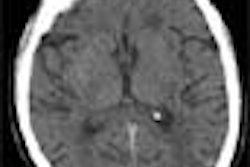CHICAGO - The use of multi-detector CT (MDCT) generates image sets of unparalleled diagnostic quality; however, obtaining these images using protocols equivalent to those used in single-detector CT (SDCT) acquisitions may be exposing patients to much higher radiation doses.
"MDCT has the potential to deliver more radiation to the patient," said Dr. Erik Paulson. Paulson presented the results of a comparative CT dose study conducted at Duke University Medical Center in Durham, NC to attendees of the RSNA.
Paulson and his colleagues compared organ doses between MDCT and SDCT using routine clinical protocols and thermoluminescent detectors placed within an anthropomorphic phantom. The phantom simulated areas of soft tissue, bone, and airspace. Within the phantom, the team was able to place 3mm thermoluminescent radiation detectors at various points to replicate position of organs in the human body.
Both CT scanners, the SDCT and MDCT (model CTi and QXi, respectively), were manufactured by Waukesha, WI-based GE Medical Systems. The group used an SDCT protocol of 140 kVp, 210 mA, a pitch of 1.5, and a 7 mm slice thickness. For the MDCT images, 140 kVp, 170 mA, a pitch of 0.75, and a 5 mm slice thickness protocol was employed. Paulson noted that the difference in pitch was due to accepted use of this setting for MDCT within the department.
The researchers scanned the pelvis area of the phantom so that the lower abdominal region received both direct and scattered radiation and the upper abdominal region received only scattered radiation. Paulson observed that the lower mA used in the MDCT protocol corrected for the focal spot-to-isocenter difference.
The team then calculated the organ dose ratio of the MDCT to SDCT on the basis of recorded levels in the detectors in the phantom. The estimated organ doses, calculated in millirads (MDCT, SDCT) were: liver (332, 197), spleen (461, 131), adrenal (687, 243), kidney (2806, 999), marrow (1894, 775), ovaries (2493, 1310), uterus (2898, 1530), and testes (644, 381). These exposures resulted in MDCT to SDCT dose ratios of 1.7 in the liver, 3.5 spleen, 2.8 adrenal, 2.8 kidney, 2.4 marrow, 1.9 ovaries, 1.9 uterus, and 1.7 for the testes.
Paulson reported that differences in organ dosage could be accounted for by the position of the x-ray tube and collimation. In the MDCT unit the tube position was located at 540 mm and a cone beam collimation was used, resulting in a wider penumbra. In the SDCT unit the tube was positioned at 630 mm and a fan beam configuration was used, resulting in a tight collimation.
The researchers discovered that even when the mA is adjusted to compensate for the focal spot-to-isocenter distance, the conversion of routine pelvic protocols from SDCT to MDCT resulted in a two to threefold increase in organ dose. Paulson urged the audience to use caution when performing imaging with MDCT, drop the mA where possible, and look to adjust their protocols and technical parameters to maintain organ doses equivalent to those found with SDCT.
By Jonathan S. Batchelor
AuntMinnie.com staff writer
November 27, 2001
For the rest of our coverage of the 2001 RSNA meeting, go to our RADCast@RSNA 2001.
Copyright © 2001 AuntMinnie.com




















